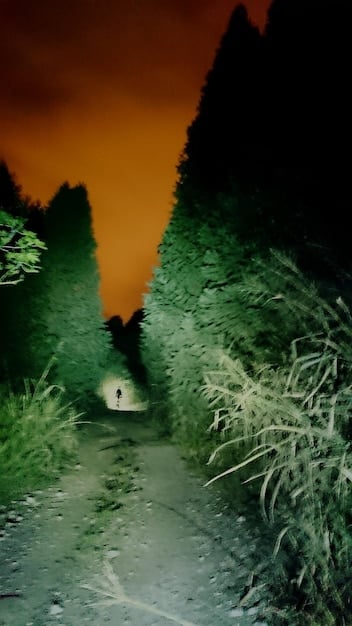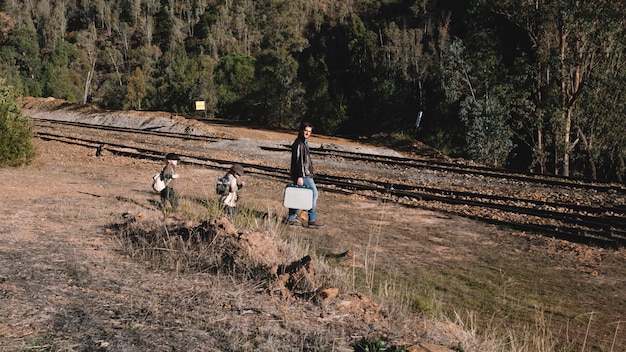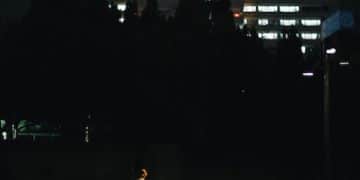Dark Ecology: US Subcultures & Climate Change Art Activism

The ‘Dark Ecology’ Movement: How US Subcultures are Confronting Climate Change Through Art and Activism explores how various subcultures in the United States are utilizing art and activism to grapple with the looming environmental crisis and its profound societal impacts.
The urgency of climate change has spurred diverse responses across American society, with subcultures playing a pivotal role in shaping innovative solutions. Among these, the ‘Dark Ecology’ Movement: How US Subcultures are Confronting Climate Change Through Art and Activism stands out as a compelling force, blending artistic expression with proactive environmental stewardship.
Understanding the Roots of Dark Ecology
Dark ecology, a philosophical and artistic movement, acknowledges the grim realities of ecological catastrophe without succumbing to despair. It encourages a confrontation with the darker aspects of environmental degradation to foster more profound and meaningful action. By embracing complexity and uncertainty, dark ecology provides a framework for subcultures to address climate change through unique lenses.
The Philosophical Underpinnings
Dark ecology challenges anthropocentric views that place humans at the center of the universe. Instead, it promotes a decentralized perspective that recognizes the agency and intrinsic value of all living beings and ecosystems. This shift in perspective is crucial for subcultures that seek to dismantle dominant power structures and create more equitable relationships with nature.
Art as a Medium of Confrontation
Artists within the dark ecology movement use their work to confront viewers with the harsh realities of environmental destruction. They employ various mediums, including visual arts, performance art, and digital installations, to evoke emotional responses and inspire critical thinking about our relationship with the environment. This approach moves beyond traditional environmental advocacy by engaging audiences on a deeply personal level.
- Decentralization: Emphasizing interconnectedness rather than human dominance.
- Confrontation: Facing ecological realities head-on without romanticizing nature.
- Emotional Engagement: Evoking empathy and concern through art and storytelling.
- Critical Thinking: Encouraging reflection on human impact and responsibility.
In essence, dark ecology provides a philosophical and artistic foundation for subcultures to engage with climate change in ways that are both intellectually rigorous and emotionally resonant. It allows for a more nuanced and multifaceted approach to environmental activism, one that acknowledges the complexities of our current predicament while still holding onto hope for a more sustainable future.
Subcultures at the Forefront of Climate Action
Numerous subcultures across the United States have embraced dark ecology as a guiding principle in their climate action efforts. From punk rock collectives to indigenous communities, these groups are leveraging their unique cultural identities and creative resources to challenge the status quo and advocate for systemic change. Their grassroots initiatives often serve as models for broader societal transformation.

Punk Rock and Environmental Resistance
The DIY ethos of punk rock has long been intertwined with environmental activism. Punk bands and collectives often address climate change in their music, lyrics, and live performances, using their platform to raise awareness and mobilize their fanbase. They also organize direct action events, such as protests and boycotts, targeting corporations and political institutions that contribute to environmental degradation.
Indigenous Communities and Traditional Knowledge
Indigenous communities possess invaluable traditional knowledge about sustainable living practices and ecological stewardship. Many indigenous groups are actively involved in protecting their ancestral lands and advocating for environmental policies that respect their rights and cultural heritage. They often view climate change as a symptom of deeper systemic injustices and advocate for decolonization as a necessary step towards ecological healing.
- Direct Action: Organizing protests and boycotts to disrupt environmentally harmful activities.
- Cultural Preservation: Protecting traditional knowledge and sustainable practices.
- Community Building: Creating resilient networks for mutual support and climate resilience.
- Advocacy: Lobbying for policy changes that prioritize environmental justice.
The diverse approaches taken by these subcultures demonstrate the power of grassroots movements in addressing climate change. By combining artistic expression, activism, and community organizing, they are creating innovative solutions that challenge the dominant paradigm and inspire others to take action.
Artistic Expressions of Dark Ecology
Art plays a crucial role in the dark ecology movement, serving as a powerful tool for raising awareness, fostering empathy, and inspiring action. Artists across various subcultures are creating works that confront viewers with the realities of ecological degradation and offer visions of a more sustainable future.
Visual Arts: Painting, Sculpture, and Photography
Visual artists are using their talents to create thought-provoking works that explore the themes of dark ecology. Paintings and sculptures often depict landscapes ravaged by pollution and deforestation, while photography captures the beauty and fragility of the natural world. These works serve as a visual reminder of the urgent need for environmental protection.
Performance Art and Activism
Performance art provides a dynamic and engaging way to address climate change. Artists use their bodies and voices to create ephemeral experiences that challenge viewers’ perceptions and provoke emotional responses. Performance art can take many forms, from street theater to immersive installations, often incorporating elements of protest and activism.
- Evoking Emotion: Creating art that resonates with viewers on a deeper level.
- Challenging Perceptions: Encouraging audiences to question their assumptions about the environment.
- Promoting Dialogue: Fostering conversations about climate change and potential solutions.
- Inspiring Action: Motivating individuals to take concrete steps towards sustainability.
Artistic expressions within the dark ecology movement are not limited to traditional forms. Digital art, interactive installations, and community-based projects are also playing a significant role in shaping public awareness and inspiring action. By leveraging creativity and innovation, these artists are helping to create a more engaged and informed citizenry.
Activism and Direct Action in the Dark Ecology Movement
Beyond artistic expression, the dark ecology movement is characterized by its commitment to activism and direct action. Subcultures are organizing protests, boycotts, and other forms of civil disobedience to challenge corporations and governments that contribute to environmental degradation. These actions often aim to disrupt business-as-usual and demand systemic change.

Confronting Corporate Power
One of the primary focuses of dark ecology activism is confronting corporate power. Activists target companies that engage in environmentally destructive practices, such as deforestation, fossil fuel extraction, and pollution. They use various tactics, including boycotts, shareholder activism, and direct action, to pressure these companies to change their behavior.
Building Community Resilience
In addition to challenging corporate power, dark ecology activists are also focused on building community resilience. They organize local initiatives such as community gardens, renewable energy projects, and mutual aid networks to create more sustainable and self-sufficient communities. These efforts are particularly important in areas that are disproportionately affected by climate change and environmental injustice.
- Disrupting Harmful Activities: Organizing direct action events to halt environmentally destructive projects.
- Holding Corporations Accountable: Exposing corporate misconduct and demanding policy changes.
- Empowering Communities: Building local resilience and promoting sustainable practices.
- Advocating for Systemic Change: Pushing for policies that address the root causes of climate change.
Activism within the dark ecology movement often involves a combination of confrontational tactics and community-building initiatives. By challenging the status quo and creating alternative models of sustainable living, these activists are paving the way for a more just and ecologically sound future.
The Role of Technology in Dark Ecology
Technology, often viewed as a driver of environmental degradation, can also be a tool for promoting ecological awareness and action. Subcultures within the dark ecology movement are leveraging technology to connect with others, share information, and organize collective action. From social media campaigns to open-source software, technology is playing an increasingly important role in advancing the movement’s goals.
Social Media and Online Communities
Social media platforms provide a valuable space for dark ecology activists to connect with like-minded individuals, share information, and mobilize support for their causes. Online communities can also serve as incubators for new ideas and strategies, fostering collaboration and innovation.
Open-Source Tools for Environmental Monitoring
Open-source software and hardware are being used to develop tools for environmental monitoring and data collection. These tools allow communities to track pollution levels, monitor deforestation, and assess the impacts of climate change. By democratizing access to environmental data, technology empowers individuals and communities to become more informed and engaged stewards of the environment.
- Networking: Connecting with activists and organizations worldwide.
- Information Sharing: Disseminating knowledge and promoting critical thinking.
- Mobilization: Organizing protests and advocacy campaigns.
- Data Collection: Gathering information to support environmental monitoring and research.
Technology, when used consciously and ethically, can be a powerful tool for advancing the goals of the dark ecology movement. By leveraging digital platforms and open-source resources, subcultures are creating new opportunities for collaboration, education, and action.
Challenges and Criticisms of the Dark Ecology Movement
While the dark ecology movement offers a compelling framework for addressing climate change, it is not without its challenges and criticisms. Some argue that its focus on the darker aspects of environmental degradation can be demoralizing and counterproductive. Others question its accessibility and relevance to marginalized communities.
Potential for Despair and Inaction
One of the primary criticisms of dark ecology is that its emphasis on the grim realities of environmental collapse can lead to feelings of despair and hopelessness. Some argue that this can be paralyzing, making it difficult for individuals to take meaningful action. It is important for dark ecology activists to balance their critique of the status quo with a sense of hope and possibility.
Addressing Issues of Accessibility and Inclusion
Another challenge for the dark ecology movement is ensuring that its message is accessible and relevant to diverse communities. Some critics argue that its philosophical underpinnings can be complex and difficult to understand, particularly for those without a background in environmental studies or philosophy. It is important for activists to engage with marginalized communities and incorporate their perspectives into the movement’s discourse.
- Balancing Realism and Hope: Finding a way to acknowledge the challenges without succumbing to despair.
- Promoting Inclusivity: Ensuring that the movement is accessible and relevant to diverse communities.
- Addressing Systemic Issues: Recognizing the intersectionality of environmental and social justice issues.
- Fostering Collaboration: Building alliances with other movements and organizations.
By acknowledging and addressing these challenges, the dark ecology movement can continue to evolve and become a more effective force for environmental and social change. Its emphasis on critical thinking, emotional engagement, and collaborative action provides a valuable framework for navigating the complexities of the climate crisis.
| Key Point | Brief Description |
|---|---|
| 🌱 Dark Ecology | Philosophical movement confronting environmental realities through art and activism. |
| 🎸 Subcultures | Punk rock, indigenous communities, and others at the forefront of climate action. |
| ✍️ Artistic Expression | Using art to raise awareness, foster empathy, and inspire environmental action. |
| 📢 Activism | Direct action and community building to challenge corporate power and promote resilience. |
Frequently Asked Questions
▼
Dark ecology is a philosophical and artistic movement that confronts the grim realities of ecological catastrophe without succumbing to despair. It encourages deep reflection on our relationship with nature.
▼
Subcultures bring unique perspectives and creative approaches, blending artistic expression with activism. They build community resilience and challenge systemic injustices linked to environmental issues.
▼
Art is a powerful medium for raising awareness, fostering empathy, and inspiring action. It helps people connect emotionally with environmental issues and drives critical thinking.
▼
Challenges include avoiding despair, ensuring accessibility and relevance to diverse communities, and addressing complex systemic issues through collaborative action.
▼
Technology helps activists connect, share information, and organize. Open-source tools aid in environmental monitoring, empowering communities to become informed stewards of the environment.
Conclusion
The dark ecology movement exemplifies how US subcultures are creatively and strategically confronting climate change. By blending art, activism, and community-building, these groups are not only raising awareness but also forging pathways towards a more sustainable and equitable future for all.





